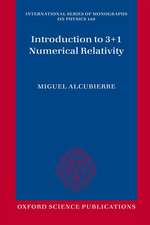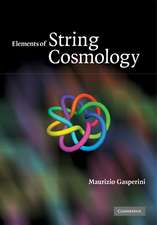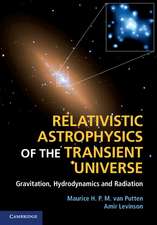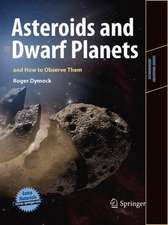Active Galactic Nuclei: Proceedings of a Conference Held at the Georgia State University, Atlanta, Georgia October 28–30, 1987: Lecture Notes in Physics, cartea 307
Editat de H. Richard Miller, Paul J. Wiitaen Limba Engleză Paperback – 23 aug 2014
Din seria Lecture Notes in Physics
- 19%
 Preț: 423.99 lei
Preț: 423.99 lei - 17%
 Preț: 360.73 lei
Preț: 360.73 lei -
 Preț: 429.22 lei
Preț: 429.22 lei - 17%
 Preț: 427.62 lei
Preț: 427.62 lei - 17%
 Preț: 460.25 lei
Preț: 460.25 lei -
 Preț: 427.96 lei
Preț: 427.96 lei -
 Preț: 481.93 lei
Preț: 481.93 lei - 17%
 Preț: 494.64 lei
Preț: 494.64 lei -
 Preț: 281.90 lei
Preț: 281.90 lei - 17%
 Preț: 493.20 lei
Preț: 493.20 lei - 17%
 Preț: 426.72 lei
Preț: 426.72 lei -
 Preț: 365.15 lei
Preț: 365.15 lei -
 Preț: 374.52 lei
Preț: 374.52 lei -
 Preț: 407.98 lei
Preț: 407.98 lei - 20%
 Preț: 428.12 lei
Preț: 428.12 lei -
 Preț: 263.30 lei
Preț: 263.30 lei - 15%
 Preț: 593.73 lei
Preț: 593.73 lei - 15%
 Preț: 528.13 lei
Preț: 528.13 lei -
 Preț: 493.12 lei
Preț: 493.12 lei - 17%
 Preț: 425.68 lei
Preț: 425.68 lei -
 Preț: 280.65 lei
Preț: 280.65 lei -
 Preț: 163.41 lei
Preț: 163.41 lei - 18%
 Preț: 726.59 lei
Preț: 726.59 lei -
 Preț: 394.84 lei
Preț: 394.84 lei - 15%
 Preț: 709.63 lei
Preț: 709.63 lei - 15%
 Preț: 623.90 lei
Preț: 623.90 lei - 20%
 Preț: 476.91 lei
Preț: 476.91 lei - 15%
 Preț: 428.05 lei
Preț: 428.05 lei -
 Preț: 342.78 lei
Preț: 342.78 lei - 18%
 Preț: 851.93 lei
Preț: 851.93 lei -
 Preț: 346.61 lei
Preț: 346.61 lei -
 Preț: 391.57 lei
Preț: 391.57 lei - 15%
 Preț: 633.16 lei
Preț: 633.16 lei -
 Preț: 451.71 lei
Preț: 451.71 lei - 5%
 Preț: 1497.80 lei
Preț: 1497.80 lei -
 Preț: 374.85 lei
Preț: 374.85 lei -
 Preț: 380.07 lei
Preț: 380.07 lei - 15%
 Preț: 516.14 lei
Preț: 516.14 lei - 15%
 Preț: 583.78 lei
Preț: 583.78 lei - 15%
 Preț: 508.60 lei
Preț: 508.60 lei -
 Preț: 469.71 lei
Preț: 469.71 lei -
 Preț: 388.90 lei
Preț: 388.90 lei - 15%
 Preț: 500.24 lei
Preț: 500.24 lei -
 Preț: 386.52 lei
Preț: 386.52 lei - 15%
 Preț: 472.88 lei
Preț: 472.88 lei -
 Preț: 424.27 lei
Preț: 424.27 lei -
 Preț: 380.07 lei
Preț: 380.07 lei - 15%
 Preț: 500.01 lei
Preț: 500.01 lei
Preț: 651.34 lei
Preț vechi: 766.28 lei
-15% Nou
Puncte Express: 977
Preț estimativ în valută:
124.63€ • 130.48$ • 103.13£
124.63€ • 130.48$ • 103.13£
Carte tipărită la comandă
Livrare economică 05-19 aprilie
Preluare comenzi: 021 569.72.76
Specificații
ISBN-13: 9783662136850
ISBN-10: 3662136856
Pagini: 456
Ilustrații: XI, 440 p. 25 illus.
Dimensiuni: 170 x 244 x 30 mm
Greutate: 0.72 kg
Ediția:Softcover reprint of the original 1st ed. 1988
Editura: Springer Berlin, Heidelberg
Colecția Springer
Seria Lecture Notes in Physics
Locul publicării:Berlin, Heidelberg, Germany
ISBN-10: 3662136856
Pagini: 456
Ilustrații: XI, 440 p. 25 illus.
Dimensiuni: 170 x 244 x 30 mm
Greutate: 0.72 kg
Ediția:Softcover reprint of the original 1st ed. 1988
Editura: Springer Berlin, Heidelberg
Colecția Springer
Seria Lecture Notes in Physics
Locul publicării:Berlin, Heidelberg, Germany
Public țintă
ResearchCuprins
Emission-line spectra and the nature of active galactic nuclei.- Emission line regions in active galactic nuclei: A unified view.- Emission-line region structure from variability studies.- UV and optical spectroscopy of NGC 5548.- The circumnuclear environment of the nearby non-interacting Seyfert galaxies NGC 5273 and NGC 3516.- Long-slit spectroscopy of star-burst galaxies.- Voyager far UV observations of Markarian 509.- High resolution study of NGC 4151.- Long-slit echelle spectrograms of Seyfert galaxy nuclei.- Double peaked broad line profiles — edge on accretion disks or double quasar nuclei?.- OJ287 as a binary system.- Line profiles and the kinematics of the narrow-line region.- Reddening of narrow line regions.- Ultraviolet and optical spectra of broad-line radio galaxies.- Long slit CCD observations of active and normal galaxies.- Imaging spectrophotometry of ionized gas in active galaxies.- Some spectroscopic properties of mass-ejecting and radio-loud quasars.- Infrared spectroscopy of NGC 1068.- Dust and emission-line asymmetries in active galaxies.- Spectropolarimetry and the structure of active galactic nuclei.- Spectropolarimetry of “narrow-line Seyfert 1s”.- Evidence for thermal emission components in highly polarized quasars.- The shape of the ultraviolet continuum of quasars.- A search for IRAS AGN.- Nuclear activity in warm IRAS galaxies.- An optical and radio survey of southern radio galaxies.- A study of Sérsic-Pastoriza galaxies.- Infrared emission and tidal interactions of spiral galaxies.- The optical variability of selected blazars.- Long-term monitoring of a large sample of active galactic nuclei.- The long term optical variability of PKS 2201 + 044.- A photometric investigation of the optical variability of Markarian 501.- The opticalvariability of Arakelian 120, 1977–1987.- Observations of the 1987 outburst of AO 0235+164.- A complete spectral analysis of the flare of the quasar 3C 273.- Broad line variations of Seyfert galaxies.- Effect of pulsed variations of the ionizing continuum on the narrow line region.- Observations and interpretation of the multifrequency continua of AGN and QSOs.- Theory of AGN continuum radiation.- Model for the continuum emission of active galactic nuclei.- Fitting multi-wavelength continuum of AGN with improved accretion disk models.- Accretion-disk modelling of the optical-UV spectrum of quasars.- Synthesis of accretion disk and nonthermal source models for AGN.- Effects of self-gravity in AGNs.- Mass and length scale of black holes in quasars and active galactic nuclei.- X-ray spectra of active galaxies.- Clues to the X-ray emission mechanisms in flat radio spectrum AGNs.- X-ray timing of active galactic nuclei.- X-ray and optical studies of iras selected AGN.- Leakage of UHE photons from AGNs: Production of X-ray and ?-ray halos within 10–30 KPC.- Radiation dynamics and pair creation in AGN accretion shocks.- Thermal comptonization in compact sources and the cosmic X-ray background.- Radio sources: Small scale structure.- The internal conditions of parsec-scale relativistic jets.- The nuclear jet in M87.- European VLBI network observations of Seyfert Nuclei.- VLBI observations of the radio lobe spiral galaxy, NGC3079.- Compact steep spectrum radio sources.- The CM-wavelength fluxes and linear polarizations of BL Lac objects.- Large scale radio structures.- Triple radio structure in the “double-nucleus” galaxy Markarian 266.- VLA observation of the M87 jet and small scale jet structures.- Extended optical line emission in powerful radio galaxies.- Theinteraction of radio jets with the narrow line region in Seyfert galaxies.- Optical continuum shapes of extragalactic radio jets.- The interaction of relativistic jets in AGNs with the ambient radiation field.- A circuit analogy for active galactic nuclei.- A model for quasi-one-dimensional narrow jets.- Two-and-one-half dimensional models of radio jets.- Linear size versus redshift and linear size versus power for extended extragalactic radio sources.- Evolution of radio jets in galactic halos and the intergalactic medium.- AGNS in clusters of galaxies and the bootes void.- Space distribution and luminosity function of quasars.- A preliminary examination of redshift and luminosity characteristics for APM survey quasars.- The evolution of active galactic nuclei: A multi-mass model.- Evolution of low luminosity quasars.- Evolutionary sequence of Seyfert galaxies.- Multiple QSO images with arcminute splittings.- Relativistic beaming, luminosity functions, and cosmology.















